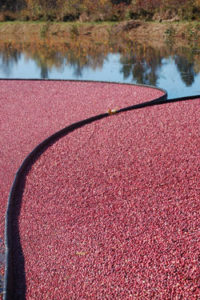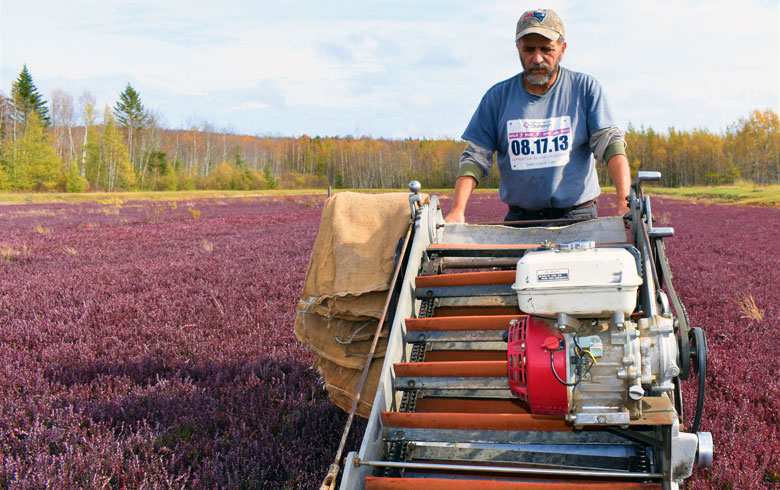In a good year, Sugar Hill Farm harvests 50,000 to 80,000 pounds of cranberries. Not surprisingly, 2020 has not been a good year, even for Maine’s drop-in-the-bucket cranberry industry.
Too hot. Too cold. Too much rain. Too little rain. Such is farming.

“If we produced 15,000 pounds this year, it would be a miracle,” says John Alexander, who has been hand-wringing throughout 2020 over the three cranberry bogs that he and spouse, Christine Alexander, are managing this year within Sugar Hills Farm’s 108-acre remote Washington County woodlot between Columbia Falls and Tibbetstown.
The week before Thanksgiving, Christine and John used to pack a small truck with berries and drive overnight to New York…
“These berries need to be totally dry before we can harvest them, and lately it’s been lots of rain,” Christine said in late October. “There was no rain when we needed it months ago.”
“We have an irrigation system, which we used in August when there was very little rain, and we’ve used it to protect the berries from frost,” John says. “This year was swamp water versus rainwater. Swamp water is swamp water. Rainwater has nutrients.”
John Alexander has spent most of his life managing and harvesting cranberry bogs. He started at age 16 in Massachusetts, the country’s second-largest producer of cranberries, after Wisconsin. Sugar Hill’s ill-fated 2020 crop is John’s 42nd year in the business, including the last 23 years Downeast.
Beyond 2020’s dismal weather, the wholesale cash market for fresh cranberries is way down.
“Nine years ago, when we harvested 200,000 pounds, we were able to get at least a dollar per pound,” John said. “It costs us 20 to 25 cents per pound to produce them, and this year a buyer at Wyman said we could expect maybe 30 cents a pound.”
 Ten years ago, there was a lucrative market for newly harvested cranberries, though not in Maine. The week before Thanksgiving, Christine and John used to pack a small truck with berries and drive overnight to New York City’s Fulton Market, located beneath the Brooklyn Bridge. There holiday shoppers would pay top dollar—as much as $4 a pound—for hard-to-find fresh, organic cranberries. Those days are over.
Ten years ago, there was a lucrative market for newly harvested cranberries, though not in Maine. The week before Thanksgiving, Christine and John used to pack a small truck with berries and drive overnight to New York City’s Fulton Market, located beneath the Brooklyn Bridge. There holiday shoppers would pay top dollar—as much as $4 a pound—for hard-to-find fresh, organic cranberries. Those days are over.
The couple once sold their fresh cranberries at the Fryeburg and Common Ground fairs and at other harvest events throughout Maine. Those days are over, too, at least during 2020, with COVID-19 concerns canceling them all.
“We’ve gone to providing our cranberries to pick-your-own orchards and farm stands,” Christine said. “We’ve also been providing berries to food co-ops and discount food pantries.”
John thinks he may have had enough. The Alexander’s cranberry ground has been for sale for the last year. “It’s been a terrible year,” John said of 2020. “I’m looking for an exit strategy, although I don’t think most people are up for this.”
Counting cranberries
Given the upcoming holidays, chances are good there are cranberries in your future. Americans consume 400 million pounds of cranberries each year, including 80 million pounds during Thanksgiving week.
More cranberry facts:
- Cranberries thrive in swamps and bogs and are one of only three fruits native to North America. The others are wild blueberries and Concord grapes
- Wisconsin farmers are America’s largest cranberry producers, providing 62 percent of the crop in 2017. Second is Massachusetts, followed by New Jersey, Oregon, and Washington
- The total number of acres of cranberries harvested in the U.S. in 2016 was 41,500; yields ranged from 5.5 to 14.4 tons per acre; the total value of that year’s crop was $292 million
- Per capita, Americans consume 2.3 pounds of cranberries annually, almost entirely in the form of juice; only five percent of the cranberries produced in the U.S. are sold fresh
- With a typical harvest of 400,000 tons, the U.S. is the world’s largest cranberry producer, followed by Canada (163,000 tons), Chile (103,000 tons), and Turkey (11,000 tons). Cranberries are also grown on a limited scale in India
Source: USDA National Agricultural Statistics Service





